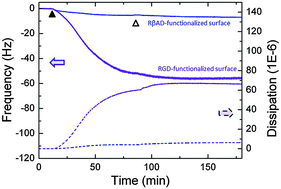Controlled surface density of RGD ligands for cell adhesion: evidence for ligand specificity by using QCM-D†
Abstract
RGD peptides (Arg–Gly–Asp) are known to promote cell adhesion. As a consequence, numerous materials have been functionalized using these peptides for several medical applications. We report herein the controlled functionalization of surfaces to study the influence of RGD density on cell selectivity. For this purpose, we selected a quartz crystal microbalance QCM-D as this technique allows real-time monitoring of cell adhesion to RGD surfaces. We observed that a critical spacing of nearly 40 nm between RGD ligands is required to observe selective cell adhesion whereas a higher density is not specific.


 Please wait while we load your content...
Please wait while we load your content...